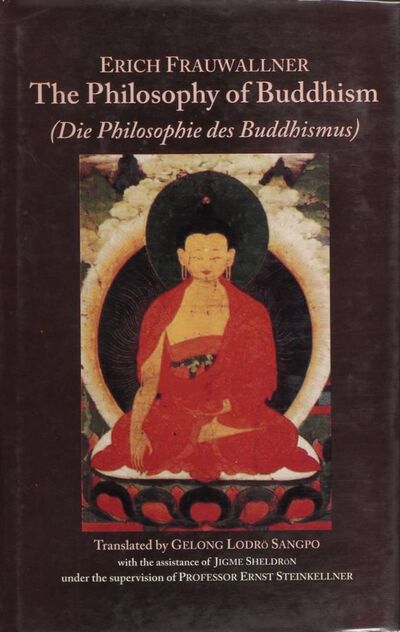No edit summary |
No edit summary |
||
| (11 intermediate revisions by the same user not shown) | |||
| Line 143: | Line 143: | ||
*****{{i|CFD.2.4. Asaṅga's Buddhology|217}} | *****{{i|CFD.2.4. Asaṅga's Buddhology|217}} | ||
****{{i|CFD.3. Introduction to the translated sections of the<br> Mahāyānasaṃgraha|218}} | ****{{i|CFD.3. Introduction to the translated sections of the<br> Mahāyānasaṃgraha|218}} | ||
****{{i|CFD.4. From the "Summary of the Mahāyāna"(Mahāyānasaṃgraha)|219}} | ****{{i|CFD.4. From the "Summary of the Mahāyāna"<br> (Mahāyānasaṃgraha)|219}} | ||
***{{i|CFE. Vasubandhu the Elder (ca. 320-380 C.E.)|231}} | ***{{i|CFE. Vasubandhu the Elder (ca. 320-380 C.E.)|231}} | ||
****{{i|CFE.1. The works of Vasubandhu the Elder and Vasubandhu the<br> Younger|231}} | ****{{i|CFE.1. The works of Vasubandhu the Elder and Vasubandhu the<br> Younger|231}} | ||
| Line 155: | Line 155: | ||
*****{{i|CFE.3.2. Chapter two: Answers to objections based on<br> scripture (verses 8-10)|236}} | *****{{i|CFE.3.2. Chapter two: Answers to objections based on<br> scripture (verses 8-10)|236}} | ||
*****{{i|CFE.3.3. Chapter three: Proof of the unreality of the external<br> world: impossibility of the concept of an atom, etc.<br> (verses 11-15)|237}} | *****{{i|CFE.3.3. Chapter three: Proof of the unreality of the external<br> world: impossibility of the concept of an atom, etc.<br> (verses 11-15)|237}} | ||
*****{{i|CFE.3.4. Chapter four: Refutation of various objections (verses 16-21)|239}} | *****{{i|CFE.3.4. Chapter four: Refutation of various objections<br> (verses 16-21)|239}} | ||
****{{i|CFE.4. "Proof that (Everything) is Mere Cognizance, in Twenty Verses" (Viṃśatikā Vijñaptimātratāsiddhi)|242}} | ****{{i|CFE.4. "Proof that (Everything) is Mere Cognizance, in Twenty<br> Verses" (Viṃśatikā Vijñaptimātratāsiddhi)|242}} | ||
****{{i|CFE.5. Introduction to the Triṃśatikā Vijñaptimātratāsiddhi|253}} | ****{{i|CFE.5. Introduction to the Triṃśatikā Vijñaptimātratāsiddhi|253}} | ||
****{{i|CFE.6. "Proof, that (Everything) is Mere Cognizance, in Thirty Verses"|254}} | ****{{i|CFE.6. "Proof, that (Everything) is Mere Cognizance, in Thirty<br> Verses"|254}} | ||
***{{i|CFF. Dignāga (ca. 480-540 C.E.)|259}} | ***{{i|CFF. Dignāga (ca. 480-540 C.E.)|259}} | ||
****{{i|CFF.1. From the "Compendium of the Means of Valid Cognition" (Pramāṇasamuccaya)|260}} | ****{{i|CFF.1. From the "Compendium of the Means of Valid Cognition"<br> (Pramāṇasamuccaya)|260}} | ||
***{{i|CFG. Sthiramati and Dharmapāla (middle of the 6th century C.E.)|262}} | ***{{i|CFG. Sthiramati and Dharmapāla (middle of the 6th century C.E.)|262}} | ||
****{{i|CFG.1. From Hiuan-tsangs "Proof that (Everything) is Mere Cognizance" (Tch'eng wei che louen)|265}} | ****{{i|CFG.1. From Hiuan-tsangs "Proof that (Everything) is Mere<br> Cognizance" (Tch'eng wei che louen)|265}} | ||
*{{i|D. Sources and Literature|271}} | *{{i|D. Sources and Literature|271}} | ||
**{{i|DA. General|271}} | **{{i|DA. General|271}} | ||
| Line 213: | Line 213: | ||
***{{i|EDB. 2. The school of Sāramati|281}} | ***{{i|EDB. 2. The school of Sāramati|281}} | ||
***{{i|EDC. 3. The school of the Yogācāra|282}} | ***{{i|EDC. 3. The school of the Yogācāra|282}} | ||
*Appendix I: Amalavijñāna and ālayavijñāna. A Contribution to the Epistemology of Buddhism. By Erich Frauwallner | *Appendix I: Amalavijñāna and ālayavijñāna. A Contribution to the<br> Epistemology of Buddhism. By Erich Frauwallner | ||
*Appendix II: Bibliography of Erich Frauwallner | *Appendix II: Bibliography of Erich Frauwallner | ||
*Appendix III: Sources and Literature (after the fourth edition) | *Appendix III: Sources and Literature (after the fourth edition) | ||
|AddRelatedTab=No | |AddRelatedTab=No | ||
|PublisherLogo=File:Motilal logo.png | |||
|ExtraCategories=Motilal Banarsidass Publishers | |||
|StopPersonRedirects=No | |||
}} | }} | ||
Latest revision as of 19:28, 15 September 2020
The translation of Erich Frauwallner's Die Philosophie des Buddhismus, first published in 1956, opens up a classic introduction to Buddhist thought to a broader English language readership. The book covers the period of early canonical literature with examples of its philosophically relevant ideas, followed by the principal philosophical concepts of systematic Sravakayana Buddhism. In the main part of the book, Frauwallner presents the first survey of the development of the philosophical systems of Mahayana Buddhism. He was well aware of the limitations in presenting only the Buddhist philosophy of the "classical", i.e., the systematic period, and does not seem to have been ready to add the philosophically creative new postsystematic tradition of Buddhist epistemology and logic, a major subject of his subsequent years of research.
Frauwallner's way of translating was straightforward: to remain as close as possible to the original text while presenting it in a clear and readable way in order to convey an accurate impression of its meaning. For technical terms in the source materials he maintained a single translation even when various meanings were suggested. For clarity regarding such variations of meaning he relied on the context and his explanation.
The same approach was taken by the translator of the present book. Although his translation attempts to be faithful to the 1994 edition of Die Philosophie des Buddhismus, he inserted helpful additional headlines into the text and considerably enlarged the index. All other additions by the translator are given within square brackets. Besides this, he created an Appendix, which contains one of Frauwallner's more important articles "Amalavijnana and Alayavijnana" (1951) to complement the long Yogacara section of the book, a bibliography of selective publications after 1969. The URLs for many of the source materials were also conveniently provided. (Source: Motilal Banarsidass)
| Citation | Frauwallner, Erich. The Philosophy of Buddhism (Die Philosophie des Buddhismus). Translated by Gelong Lodrö Sangpo with the assistance of Jigme Sheldrön, under the supervision of Ernst Steinkellner. Delhi: Motilal Banarsidass, 2010. Originally published 1956 by Akademie Verlag as Die Philosophie des Buddhismus (Berlin). |
|---|---|


